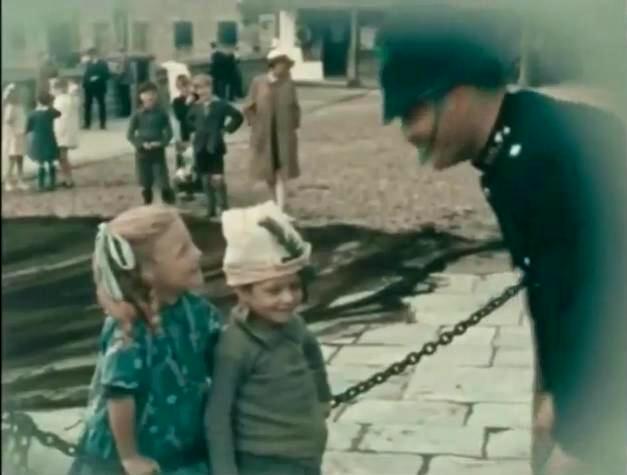
Early Color Photography: Biocolour

Figure 1.---There are some interesting Biocolour images in color of children and their attire in late-1920s. Here we see two children with a Bobby in Plymouth. A boy in the background walks along stops and pulls up his socks. The woman in the brown coat seems to be his mother. It is from this place that the Pilgrim Fathers sailed to America. from the 'Open Road'.
|
|
William Friese-Greene was especially interested in color at a time that there was no commercially viable color process. One of the most unteresting aspect of Friese-Greene's work with motion pictures was his development of the additive color film process which he called called 'Biocolour' because it was based on adding two colors to the film. The Biocolour process produced an illusion of color by exposing alternate frames of ordinary black-and-white film stock through two different colored filters. Each alternate frame of the monochrome (black and white) print was then stained red or green--a slow process. The projection of Biocolour prints did provide an illusion of true color, depending on how the film was exposed. Bright sunlight oproduced the best results, but a duller day and the colors are not so good. Trees are anything but green and don't stand out from the background. Filming in the rain was a dead loss the images is very blue. Indeed brown and blue seem to be the main colours. True color as produced by modern film and television require three colors. We are not sure if Friese-Greene tried that. There were a range of limitations with the Biocolour system, noticeable flickering and red-and-green fringing with rapid motion. Even so, as the only early color system, it was an impressive first step. His is work is today largely unacknowledged. Unfortunately, legal difficulties over copytights impaired his efforts. He encountered all kinds of financial and legal problems. Much of his work was carried out in the late-19th century. After the turn-of the-20th century he and his son was involved in intractable legal battles, the nature of which, partially explain why England lagged behind in both motion pictures and color photography. George Albert Smith and Charles Urban filed a lawsuit against William Friese-Grene (1911). They claimed that the Biocolour process infringed upon Smith's color photographic pantents for a process that he called Kinemacolor. Friese-Grene won the first legal test, but in 1914 the House of Lords reversed the favorable decision. As a result, Friese-Greene was unable to exploit the Biocolour system commercially as he had hoped. The House of Lords reversed itself again, and ruled against Kinemacolor (1915). After his father's death, Claude Friese-Grene changed the name of Biocolur rene Natural Colour and used it to sgoot the first British color films. The most famous was the 'Open Road'.
HBC

Navigate the Boys' Historical Clothing Web Site:
[Return to:Main William Friese-Greene page]
[Return to:Main color photography page]
[Return to:Main photographer page]
[Introduction]
[Activities]
[Biographies]
[Chronology]
[Clothing styles]
[Countries]
[Bibliographies]
[Contributions]
[FAQs]
[Glossaries]
[Images]
[Links]
[Registration]
[Tools]
[Boys' Clothing Home]
Created: 2:37 AM 2/28/2011
Last updated: 2:37 AM 2/28/2011



